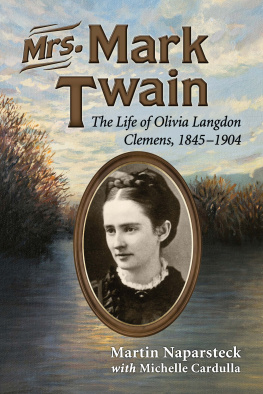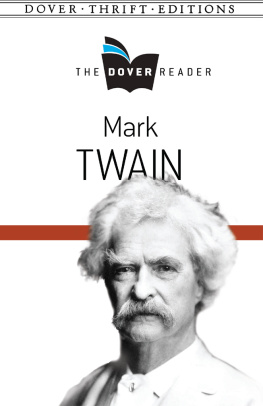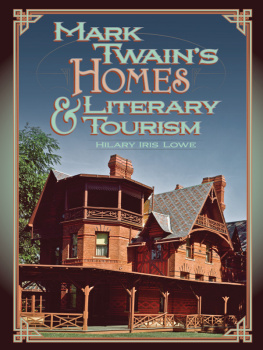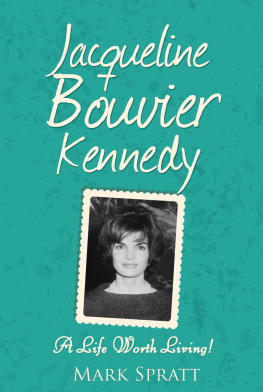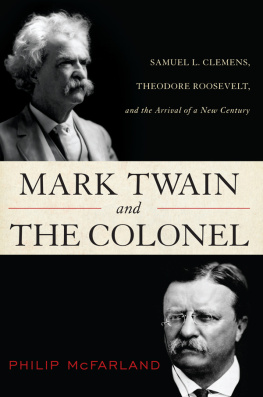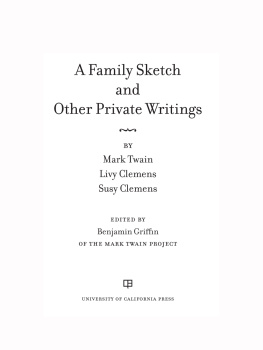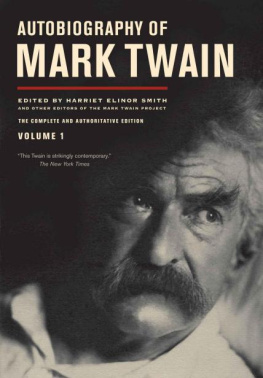
Mrs. Mark Twain
The Life of Olivia Langdon Clemens, 18451904
MARTIN NAPARSTECK with MICHELLE CARDULLA

McFarland & Company, Inc., Publishers
Jefferson, North Carolina
ALSO OF INTEREST
Sex and Manifest Destiny: The Urge That Drove Americans Westward, by Martin Naparsteck (McFarland, 2012)
Richard Yates Up Close: The Writer and His Works, by Martin Naparsteck (McFarland, 2012)
LIBRARY OF CONGRESS CATALOGUING DATA ARE AVAILABLE
BRITISH LIBRARY CATALOGUING DATA ARE AVAILABLE
e-ISBN: 978-1-4766-1309-3
2014 Martin Naparsteck and Michelle Cardulla. All rights reserved
No part of this book may be reproduced or transmitted in any form or by any means, electronic or mechanical, including photocopying or recording, or by any information storage and retrieval system, without permission in writing from the publisher.
On the cover: Olivia Langdon Clemens as a young wife, c. 1872 (Mark Twain House, Hartford, Connecticut); artwork Light at the End of Day (iStockphoto/Thinkstock)
McFarland & Company, Inc., Publishers
Box 611, Jefferson, North Carolina 28640
www.mcfarlandpub.com
For all the women who,
like Livy Langdon Clemens,
do not receive the
recognition they deserve
Acknowledgments
Thank you to Barbara Snedecor, director, Center for Mark Twain Studies, Elmira College, for permitting a useful and informative stay at Quarry Farm; to Tim Morgan, Quarry Farm caretaker, for hosting that stay and answering so many questions; to the helpful staff in the Grosvenor Room of the Buffalo and Erie County Public Library, which houses the original manuscript of The Adventures of Huckleberry Finn; to the friendly staff at the Chemung Valley History Museum in Elmira; and to all those, far too numerous to list, who offered words of encouragement.
Preface
Olivia Langdon grew up in the richest family in Elmira, New York, the daughter of loving, compassionate parents, with a devoted older sister and an admiring younger brother, and she married a man just beginning to become the best-known, and probably the best-loved, American in the world. Her husband loved her and was always kind to her. As a child and as an adult her needs were met by capable and considerate servants. She was intelligent and gifted. She loved literature and met and befriended many of the major literary luminaries of her era. She traveled around the world and lived a decade in European countries; also in a mansion she helped to design in Connecticut. Everyone who knew her and left a written record of what she was like praised her. They praised her beauty, her intelligence, her charm, her basic decency.
Yet there can be no doubt that her life was a tragic one. She was bedridden for years at a time with various ailments. Her son, born prematurely, lived only a year and a half. Her oldest daughter died at 24. Her youngest daughter was epileptic. Her husband invested foolishly and drove the family into bankruptcy.
This is the story of her life. It is not a biography of her husband, Mark Twain. Anyone looking for a biography of Twain will be disappointed. Most of what happened in his life is omitted from this volume. That is a deliberate choice. He was and remains such an imposing figure, he could only obscure the woman he cared about so much. Yet its obvious that no one today would have any interest in Olivia Langdon if she had married, say, a wealthy Elmira businessman. Or if she had never married. Our interest in her today derives entirely from her marriage to the man whose towering fame still threatens to make impossible any attempt to see her as an individual. The only book previously written about her was actually a dual biography about both her and her husband. Much of the rest that has been written about her has been in passing references, often in scholarly articles, suggesting or stating directly that she had an inhibiting effect on her husbands writing. And much of what has been written emanates from the character named Mrs. Clemens that Mr. Clemens created, just as he created the character named Mark Twain. He created her in conversations with his friends, in letters to friends and in-laws and relatives, and in his autobiography. And that character isand this is always presented in obvious jestsomeone to be feared. Why, an editor, wanted to know, did you take out the profanity? Because Mrs. Clemens made me. Why did you do that? Because Mrs. Clemens told me to. Why did you not do this? Because Mrs. Clemens forbade me. Mrs. Clemens, Livy, indeed was able to get him to behave himself. When she heard him once on the telephone yelling at the person on the other end, she put her finger to her lips and he immediately became calm. When he yelled at the maid, Katy Leary, Livy defended her and calmed him. And when his bad investments drove the family into bankruptcy, Livy never scolded him but insisted that they pay back every penny. And they did.
But we approached this biography with a prejudice, one useful, we think, to any biographer. We assumed there was an Olivia Langdon Clemens who was an individual, who, while forever in the public mind a part of her husbands identity, was also a person with her own thoughts and attitudes and personality. And we found her.
Katy Leary, their maid for 30 years, told us who she was. William Dean Howells, their friend, told us about her. So did two of their daughters, Susy and Clara. And so, too, did Mark Twain. He told us in those same letters and that same autobiography in which he presented Mrs. Clemens to the world as another woman, a woman named Livy, a woman who called him Youth, who shared some traits with Mrs. Clemens but who had a distinct, recognizable personality.
We sensed who she was when we walked around Elmira, around the same neighborhoods she grew up in. During a stay at Quarry Farm, where she spent 20 summers. By going page by page1,400 pages in allthrough the digital copy of the original manuscript of The Adventures of Huckleberry Finn at the Buffalo and Erie County Public Library, looking for evidence that she may have influenced the writing of her husbands most famous book. By standing next to the bed she slept in as a child, now on display on the Elmira College campus. By searching through hundreds of books and articles about her husband, about Victorian America, about the places she had lived and visited, about the diseases that afflicted her and her children.
She was a Victorian woman. Or, more precisely, an American woman of the American Victorian age. She was, by the standards of her time, very well educated, having been sent to an expensive private school and being among the first few hundred women in the country to attend college. Her wealthy father, in fact, helped to fund the college. He and his wife were leaders in Elmiras anti-slavery movement and in believing females had as much right to be educated as men. And they hired private tutors for her. But beyond that, much of her education came from the extensive reading she did, as did everyone in the Langdon family. And from meeting the cultural and political leaders who visited her parents home, including Frederick Douglass, William Lloyd Garrison, and Gerrit Smith, perhaps the three most important leaders of the abolitionist movement. After she was married she continued to meet famous people, including Ulysses S. Grant, Charles Dickens, Lewis Carroll, Ivan Turgenev, and kings and queens. She became so accustomed to meeting important and famous people that she was surprised when she missed an opportunity to have an audience with Pope Leo XIII.
Next page
